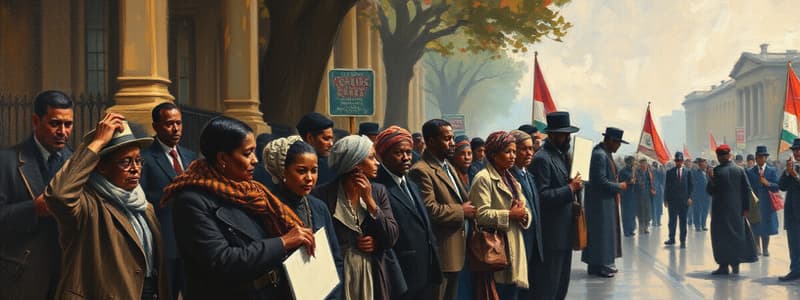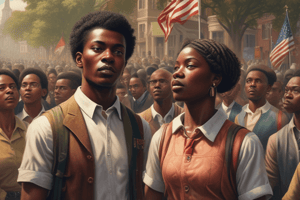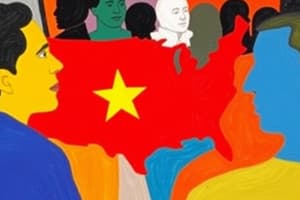Podcast
Questions and Answers
What was one of the primary goals of the Civil Rights Movement in the 1950s?
What was one of the primary goals of the Civil Rights Movement in the 1950s?
- To establish separate facilities for Black people
- To end segregation and discrimination against Blacks (correct)
- To promote segregation in schools
- To encourage Black Americans to leave the United States
Which event is closely associated with the desegregation of public schools?
Which event is closely associated with the desegregation of public schools?
- The emergence of Freedom Riders
- Montgomery bus boycott
- The March on Washington
- Brown v. Board of Education ruling (correct)
What was a significant challenge faced by the Civil Rights Movement?
What was a significant challenge faced by the Civil Rights Movement?
- High levels of funding and resources
- Assassination and murder of leaders (correct)
- Total support from the government
- Insufficient media coverage for events
Which of the following was NOT an event associated with the Civil Rights Movement?
Which of the following was NOT an event associated with the Civil Rights Movement?
What role did the Civil Rights Movement play in U.S. legislation?
What role did the Civil Rights Movement play in U.S. legislation?
Study Notes
Overview of the Civil Rights Movement
- Aimed to eliminate segregation and discrimination against Black Americans in the 1950s.
- Focused on achieving equal rights and freedoms for Black individuals.
Key Events
- Brown v. Board of Education: Landmark Supreme Court ruling that declared racial segregation in public schools unconstitutional.
- Little Rock Nine: Group of nine Black students who integrated Central High School in Little Rock, Arkansas, symbolizing the struggle against segregation.
- Montgomery Bus Boycott: Sparked by Rosa Parks' arrest; this protest against racial segregation on public buses lasted over a year and led to a Supreme Court ruling that segregation on public buses was unconstitutional.
- Freedom Riders: Integrated groups who traveled by bus through the South to challenge segregation in bus terminals.
- March on Washington: Major civil rights rally that culminated in Martin Luther King Jr.'s "I Have a Dream" speech, emphasizing the demand for jobs and freedom.
Impact of the Movement
- Played a crucial role in prompting legislative changes aimed at promoting equality.
- Contributed to the creation of laws that abolished discriminatory practices, including segregation.
Challenges Faced
- Movement leaders faced severe repression from government entities.
- Over ten leaders were assassinated, and many experienced threats and physical violence.
- Funding for movement activities was often limited, hindering progress.
Achievements
- Despite facing oppression and challenges, the movement succeeded in reducing racial discrimination and fostering greater equality in American society.
Studying That Suits You
Use AI to generate personalized quizzes and flashcards to suit your learning preferences.
Description
This quiz explores the key events and milestones of the Civil Rights Movement in the 1950s, aimed at ending segregation and discrimination against Black Americans. Test your knowledge on significant events such as Brown v. Board of Education, the Montgomery Bus Boycott, and the March on Washington.




